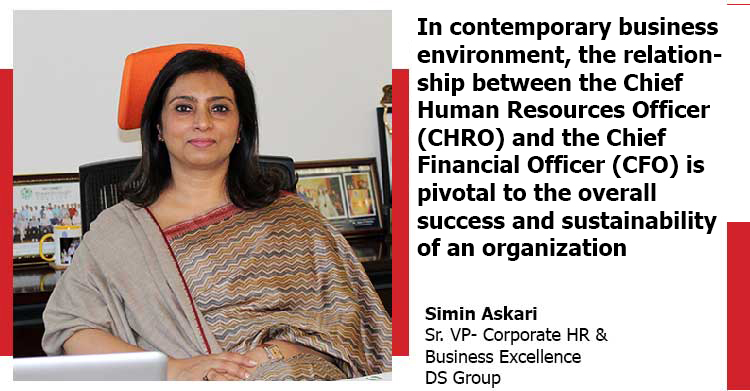The relationship between the CHRO and the CFO is more than just important; it is crucial for the success of modern organizations | Simin Askari | Sr. VP- Corporate HR & Business Excellence | DS Group

In contemporary business environment, the relationship between the Chief Human Resources Officer (CHRO) and the Chief Financial Officer (CFO) is pivotal to the overall success and sustainability of an organization. Traditionally seen as separate entities within the corporate structure, these two roles have increasingly converged, necessitating a collaborative approach to achieve strategic objectives.
The CHRO is responsible for managing an organization’s human capital, including recruitment, retention, training, and development. This role is vital for fostering a productive work environment and maintaining a competitive edge through a skilled and motivated workforce. On the other hand, the CFO oversees the financial health of the organization, ensuring that resources are allocated efficiently and that financial risks are managed effectively. Historically, the roles of CHRO and CFO were perceived as distinctly separate, however, the modern business landscape demands a more integrated approach.
For organizations to thrive, the CHRO and CFO must collaborate as equal partners. This partnership involves integrating human resource strategies with financial planning to create a cohesive approach to achieving organizational goals. One key area where this collaboration is evident is in budgeting and resource allocation. By working together, the CHRO and CFO can ensure that investments in human capital are aligned with financial
constraints and strategic priorities.
The collaboration between the CHRO and CFO can lead to more informed decision-making processes. For instance, when considering mergers and acquisitions, the CHRO can assess the cultural compatibility and potential impact on employee morale, while the CFO evaluates the financial benefits and risks. Furthermore, the synergy between these roles is essential for driving organizational change. Whether it is implementing new technologies, restructuring, or expanding into new markets, change initiatives require both financial backing and effective change management strategies. The CHRO can provide insights into how changes will impact employees and what support they will need, while the CFO can ensure that the necessary financial resources are available and that the initiatives are cost-
effective.
In the area of talent management, the CHRO and CFO can collaborate to develop compensation and benefits packages that are both competitive and financially sustainable. This partnership ensures that the organization attracts and retains top talent without compromising its financial stability. Additionally, in performance management, the CHRO
can align employee performance metrics with financial goals, ensuring that individual and team performance directly contributes to the organization’s financial success.
Rapid technological advancements also amplify the need for this convergence between the two functions. The integration of cutting-edge technologies like artificial intelligence, automation and data analytics into business processes demands substantial financial investment. At the same time, these technologies profoundly impact the workforce, altering job roles and skill requirements. Therefore, financial strategies must be closely coordinated
with HR initiatives to ensure that investments in technology are complemented by robust training and development programs, facilitating smooth transitions and maximizing return on investment.
Despite the clear benefits of a strong CHRO-CFO partnership, challenges can arise due to differing priorities and perspectives. The CHRO may prioritize long-term investments in employee development, while the CFO may focus on short-term financial performance.
There is also a difference in the approaches to risk management. The CHRO may be more willing to take risk in areas such as recruitment, employee engagement initiatives and trainings, seeing this as necessary for driving innovation and maintaining a competitive edge. However, the CFO may adopt a more conservative approach and may hesitate to
allocate funds to initiatives that do not have guaranteed returns. To overcome these challenges, it is crucial to establish open lines of communication and foster a culture of mutual respect and understanding. Regular joint meetings and collaborative planning sessions can help bridge the gap between human resources and finance. Cross functional trainings can help the HR and Finance employees understand each other’s’ perspectives.
Additionally, leveraging data analytics can provide a common ground for decision-making, as both the CHRO and CFO can rely on data-driven insights to support their strategies. Implementing a balanced score card approach can also help bridge the gap between financial and non-financial performance measures. Focus on shared goals and a clear
understanding of how their respective strategies contribute to overall organizational success, help build a strong partnership between the two functions.
The relationship between the CHRO and the CFO is more than just important; it is crucial for the success of modern organizations. As equal partners, the synergy between people and finance is fundamental to thriving in today’s competitive business environment.


